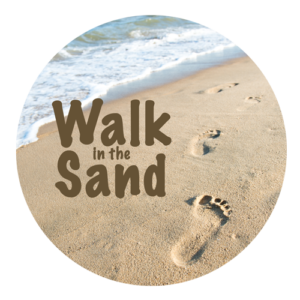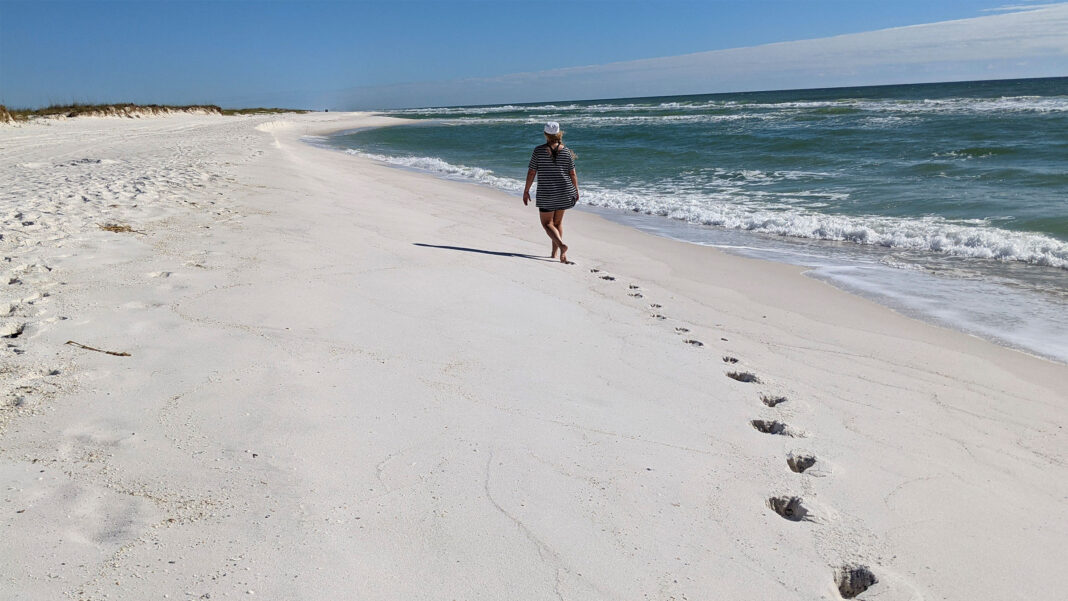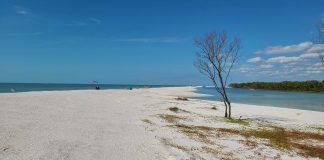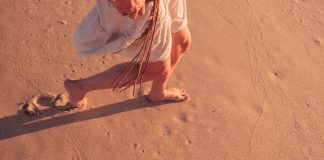Beach hiking is more than just a walk, it’s an experience that tests your endurance, calms your mind, and immerses you in the wonders of coastal landscapes.
Imagine the sun rising over the horizon, the soothing sound of waves breaking along the shore, and the invigorating challenge of trekking through shifting sands. Beach hiking offers a unique blend of physical endurance, meditative calm, and opportunities for exploration.
While there are no specific trails along the coasts, except in the many parks that offer back trails, walking on the beach is an adventure along the worlds most beautiful natural resource. You will discover the wildlife that inhabits the coasts, the tranquility of the waves, and the treasures they bring you.
The true magic of hiking on the beach isn’t just in what you see, it’s in what you feel. There’s a peculiar weightlessness that comes not just from the buoyancy of water but from the psychological unburdening that happens when your only responsibility is to place one foot in front of the other, again and again, while the endless horizon reminds you just how vast and beautiful this world can be.
And yes, you’ll find sand in your car for weeks afterward. Consider it a souvenir—one you can’t quite manage to throw away.
Key Tips for a Successful Beach Hike
Know the Sand Type & Decide on Wet or Dry
Knowing the type of sand and where you plan to walk is the most important aspect when walking on the beach. Some beaches have compact sand that is ideal for walking in sneakers. Other beaches have soft sand that is like walking on an elliptical and will tire you out much more quickly.
Dry sand is typically softer and more difficult to walk on, but often spectacular for barefoot walking on the softer sand beaches. Wet sand along the shore may or may not be more firm. In locations with courser sand, the shoreline may be smushier (like that elliptical) so you will get more of a workout. If you decide to walk in the shallow water, you may need water shoes to protect your feet. Shellier sand can be hard on your feet or contain sharp broken shell pieces, so it is a good idea to have your sneakers or water shoes on hand. Rocky beaches will also require footwear to protect your feet.
Plan Around the Tides
Low tides offer a wider beach and more wet, typically more packed sand. High tide will reduce available walking space and may make it more difficult to have a clear path around certain areas. Some beach locations are much prettier at high tide while others offer spectacular sand bars and shallow water walking at low tide. Check the tide charts with an app or simply google it to plan your hike timing.
Physical Preparation & Length of Hike
The beauty of a beach hike is that you can precisely walk the distance you choose. There is no set path or trail since you are walking along the shoreline and can turn around at any time.
What I love about hiking on the beach is that it is a great way to push yourself a little without over-doing it. I’d recommend starting with a short hike and work your way up to longer distances. My starting goal was to walk at least a mile on every beach in Florida. For me, this meant walking across a mile of beachfront which is a 2 mile round trip.
Now I tend to walk 2-3 miles in one direction and then turn around making it a 4-6 mile hike. Remember, walking in the sand can be tougher and more challenging so pace yourself and be aware of the softer sand beaches that will tire you out faster.
I highly recommend a walking app to keep updated on your distance as well as using it to stay oriented as to your location. You may want to pin your starting point and distance goal on your app to you can keep track of your progress.
It’s a good idea to stretch before, during and after to help prevent injuries and soreness. Because walking in the sand can be harder on the feet, I highly recommend stretching your feet and ankles and wearing any protection you may need. I often wear heal cushion for my plantar fascia since that is an injury I had in the past.
Adding a Sense of Adventure with a Themed Hike
Walking on the beach is more than just a hike, it is an adventure. Find a purpose or theme for your hike and make it more fun!
Sunrise or Sunset Walks
Time your hike to witness the sky painted in vibrant hues. One of my favorite spots is Pensacola beach in the fall when both the sunrise and sunset are across the edge of the water. Morning sunrise walks are spectacular for birding, shelling, photography or just enjoying the beauty of it all. Sunsets are a more popular time (maybe because many people don’t want to get up too early? or maybe because it is a perfect spot for relaxing after work or after dinner.)
Night Hiking
Explore the beach under a canopy of stars, guided by the gentle rhythm of waves. Hint, bring a flashlight as many beaches are very dark, but be aware of the no flashlight zones during turtle nesting season.
Shell Collecting aka Shelling
Turn your hike into a treasure hunt for unique shells and sea glass. There is something magical about finding a special beautiful shell from the sea. Just be sure there is no live animals inhabiting it!
Camping
Some beaches allow tent camping on the beach where you can hike to a more secluded spot and pitch your tent. Check the guidelines for the distance and be sure to bring all your gear!
Combine Activities
One of my favorite things to do when hiking on a beach is to walk a mile down the beach to a more secluded area, then drop my backpack and get in the water with my goggles and wade along the shallow water. (Note: I don’t recommend going to more secluded areas alone and swimming alone for safety purposes.) The main idea is to combine other activites with your hike. Do some body surfing, shelling, fishing, yoga, or bring a football or frisbee and get some play time in!
Essential Elements for Beach Hiking
Clothing and Gear
Obviously the clothing depends on your location, season, weather and temperature so be sure to dress warn or cool enough. I have hiked in the cold misty rain, near freezing temperatures, and temperatures so hot I had to get in the water to cool down along the hike. It’s important to dress accordingly to the weather, wear moisture-wicking fabrics or swimwear, and consider UV-protective clothing.
Beach hikes rarely have any shade! Be prepared for extreme bright sunshine and the suns glare on the white sands and be sure to wear sunglasses and a hat. These are two things I rarely go without!
Choosing the proper footwear is also dependent on the weather and temperature of the water (if you plan to walk along the shallow waters). I tend to wear my water shoes or my beach sneakers when taking long hikes and always prepare to take them off if the sand is less shelly and soft.
I never hike on the beach without my backpack. My phone and keys go in a water-proof case so I can keep those on me if I am getting in the water. I also pack a mesh bag for shells and plastic zip locks for smaller shells and other special finds. A water bottle is essential to stay hydrated, particularly on very hot days and/or longer hikes as well as any snacks to keep your energy level up. I do not personally bring a towel (I keep mine in the car for when I get back), but if you like to dry off or want to take a break and have a towel to sit on, by all means, bring a towel. And one of the most important things for me is sunscreen (since I have fair skin!) and an SPF lip balm. Having first-aid kit essentials is a good idea for those mishaps that may occur such as stepping on a sharp object or blisters.
Environmental Respect
There are so many reasons that make beach hiking amazing including the natural beauty, wildlife and shelling fun. It is important to leave no trace along your walk and bring your trash with you or find a garbage can that is typically near the parks or buildings along the beachfront. Also respect the ecosystems like dunes and tide pools and stay on the designated paths. Observe marine life from a distance and be aware of signs to keep off of areas where nesting turtles, birds and other wildlife inhabit.


















